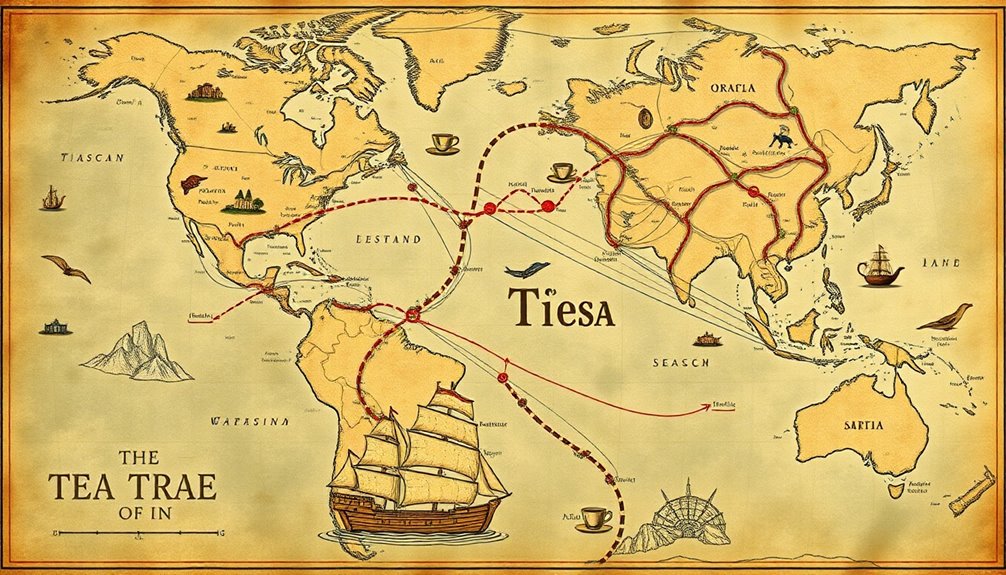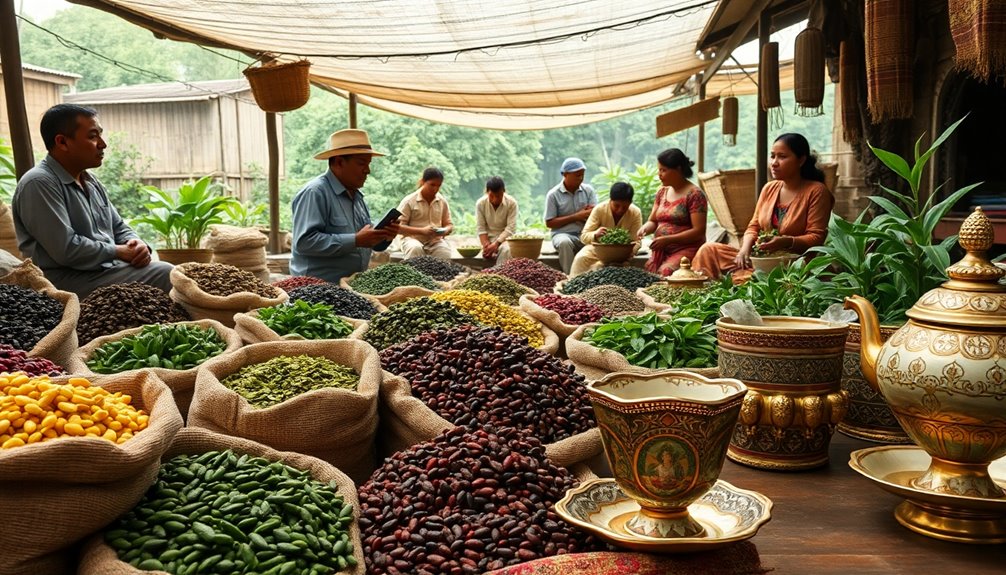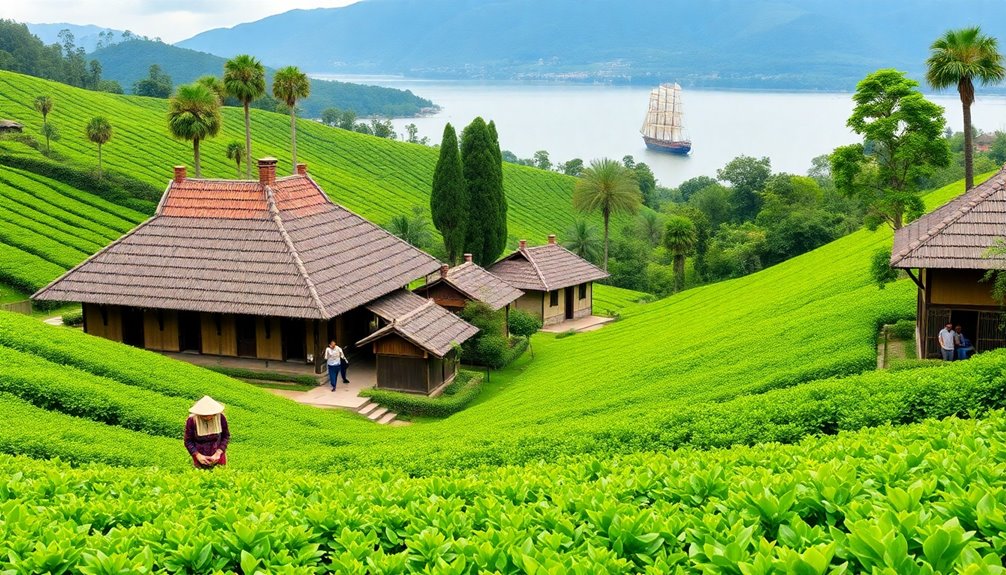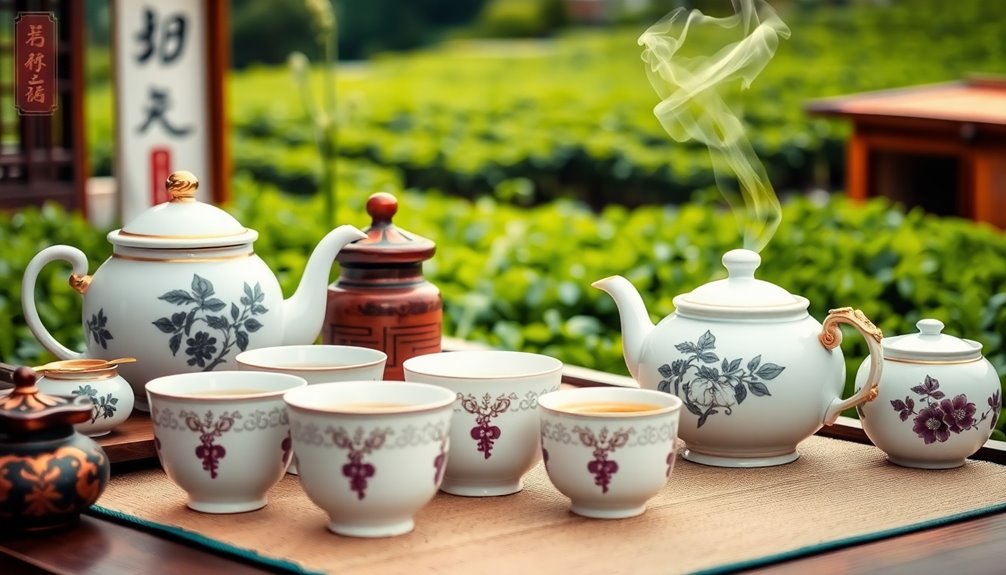Colonialism drastically reshaped the global tea industry by intertwining it with exploitation and power dynamics. The British East India Company dominated the tea trade, establishing routes that connected India, China, and Europe. Local labor was exploited through brutal practices, distorting traditional tea cultures. With the introduction of industrialized production, tea became a commodified global product, leading to significant pricing inequalities. This legacy continues to influence multinational corporations today, often overshadowing intricate regional practices. If you’re curious about the cultural rituals and historical nuances surrounding tea, there’s much more to uncover.
Key Takeaways
- The British East India Company’s control established direct trade routes, reshaping the global tea market and reducing reliance on Chinese tea.
- Colonial exploitation of local labor, including indentured servitude, created a system of brutal efficiency in tea production.
- The commodification of tea during colonialism led to mass production, often sacrificing quality for profit.
- Taxes imposed by colonial powers, like the 1773 Tea Act, manipulated tea pricing and fueled colonial tensions.
- Colonial narratives influenced consumer preferences, overshadowing traditional tea practices and regional cultural significance.
Introduction

Tea, a beloved beverage across the globe, has a complex history intertwined with colonialism that reshaped its production and trade. You mightn’t realize that the discovery of tea in China nearly 5,000 years ago sparked a cultural phenomenon that colonial powers, particularly the British, capitalized on during the 17th century.
The British East India Company played a pivotal role in this process, establishing control over tea trade routes and production in colonies like India, Sri Lanka, and Africa.
As you delve into the history of tea, you’ll uncover how British colonial practices exploited local labor through indentured servitude and penal laws, enabling large-scale tea production to satisfy European demand.
The introduction of taxes on Chinese tea not only funded British naval endeavors but also manipulated the global tea market, impacting pricing structures.
Moreover, British marketing strategies promoted tea as a quintessential global commodity, often overshadowing the historical injustices tied to its production.
Understanding this context enriches your appreciation of tea, revealing layers of exploitation and globalization that have shaped its journey from colonial plantations to your cup.
Tea Trade Routes Established Globally

As the British East India Company forged direct trade links between India, China, and Europe in the 17th century, it revolutionized the movement of tea across continents.
This pivotal shift established new trade routes that facilitated the global tea trade, which would soon be dominated by colonial powers. By the late 19th century, these powers controlled two-thirds of the tea trade, using well-established shipping routes to transport tea from plantations in India and Sri Lanka to eager consumers in Europe and beyond.
The introduction of tea cultivation in India and Sri Lanka was a strategic maneuver, creating alternative sources of tea and reducing reliance on Chinese production.
Major shipping ports like Calcutta and London became crucial hubs, connecting producers with markets.
The Opium Wars further exemplified the intertwining of tea and colonial trade networks, as the British sought to balance their trade through the export of opium from India to China.
These developments reshaped global trade dynamics, allowing tea to flourish as a commodity and solidifying its status in the international market.
Understanding these trade routes gives you insight into how colonialism fundamentally altered the global tea industry.
Colonial Exploitation of Tea Labor

Under the guise of progress and economic expansion, the British colonial system exploited tea labor with brutal efficiency. The East India Company established tea plantations in India, relying heavily on indentured workers, or coolies, who were often deceived into relocation from central India to Assam. This system resembled slavery, using violence and coercion to maintain a workforce that was trapped in a cycle prioritizing profit over human rights.
The legacy of colonialism remains evident today, as many tea producers in former British colonies still operate under multinational corporations that perpetuate these oppressive economic structures.
As tea cultivation industrialized, traditional practices were disregarded, leading to the commodification of tea that often overlooks the historical injustices faced by laborers.
Contemporary consumer preferences are shaped by colonial narratives, favoring machine-made tea over handcrafted varieties, further entrenching the exploitative practices rooted in colonial exploitation.
This history reminds us that the origins of your cup of tea aren’t just about flavor, but also about the struggles and sacrifices of those who labor behind the scenes.
Cultural Rituals Around Tea

Colonial exploitation of tea labor not only shaped economic structures but also influenced cultural practices surrounding the drink. You might notice how the British afternoon tea tradition exemplifies this, turning tea into a commodified social ritual focused on status and leisure, rather than acknowledging its rich cultural significance in places like China and Japan.
In Chinese tea culture, various ceremonies highlight flavor, aroma, and the artistry of tea preparation, reflecting deep historical roots. Meanwhile, the Japanese Tea Ceremony, or Chanoyu, emphasizes harmony, respect, and tranquility, offering a spiritual experience that starkly contrasts with British customs.
Across the globe, tea serves as a cultural bridge, uniting people through communal rituals. For instance, Moroccan mint tea symbolizes hospitality and social bonding, showcasing how diverse societies integrate tea into their lives. Moreover, flower teas, such as chamomile tea, are often incorporated into these rituals for their calming effects and health benefits.
However, the colonial legacy has led to a misrepresentation of these practices, often overshadowing the intricate, region-specific traditions that thrive worldwide. By understanding these rituals, you can appreciate the rich tapestry of tea culture beyond the simplistic narratives shaped by colonial influences.
Colonialism’s Impact on Tea Pricing

Throughout the 18th century, the British East India Company‘s control over the tea trade drastically altered pricing structures and economic landscapes in colonized regions. By monopolizing tea production, the Company manipulated tea prices to maximize profit margins, often at the expense of local economies.
Colonial practices, such as forced relocation of laborers and widespread indentured servitude, created a labor market that suppressed wages, allowing European traders to keep tea prices artificially low.
The introduction of industrialized tea production methods in British-controlled India led to mass production of lower-quality tea, further distorting global pricing structures. This shift meant that while the British East India Company profited immensely, the economic injustices faced by local producers deepened.
Taxes on imported teas, like the 1773 Tea Act, were specifically designed to benefit the Company, inflaming tensions and protests among American colonists who felt the weight of these unfair practices.
Today, the historical impact of colonialism is evident in modern tea prices, which still reflect the legacies of these global market inequalities. Understanding this history helps you appreciate the complexities behind every cup of tea you enjoy.
Practical Applications

Understanding the practical applications of tea’s colonial history can enhance your appreciation of this beloved beverage.
The British East India Company‘s aggressive tactics in establishing tea plantations across India, Sri Lanka, and Africa shaped the global tea market, allowing them to control two-thirds by the late 19th century. Recognizing these colonial practices helps you see the roots of exploitation of labor, particularly the use of indentured workers under harsh conditions resembling slavery.
Moreover, the intertwining of tea with the transatlantic slave trade, fueled by the demand for sugar imports, reveals the darker side of this cherished drink.
The marketing strategies developed by the British not only promoted tea as a global commodity but also laid the foundation for modern globalization and consumer culture. This legacy persists in contemporary global tea markets, where former colonies often serve European-based multinational corporations.
Conclusion
In conclusion, colonialism profoundly shaped the global tea industry, influencing everything from trade routes to labor practices. You can see how these historical events have woven tea into the fabric of cultures worldwide, creating rich rituals and traditions. However, it’s essential to recognize the lasting impacts of colonial exploitation, especially on pricing and labor. By understanding this history, you can appreciate your next cup of tea not just for its flavor, but for the complex story behind it.










